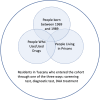Evaluating hepatitis C cascade of care surveillance system in Tuscany, Italy, through a population retrospective data-linkage study, 2015-2021
- PMID: 38553731
- PMCID: PMC10979555
- DOI: 10.1186/s12879-024-09241-z
Evaluating hepatitis C cascade of care surveillance system in Tuscany, Italy, through a population retrospective data-linkage study, 2015-2021
Abstract
This comprehensive retrospective data-linkage study aimed at evaluating the impact of Direct-Acting Antivirals (DAAs) on Hepatitis C Virus (HCV) testing, treatment trends, and access to care in Tuscany over six years following their introduction. Utilizing administrative healthcare records, our work reveals a substantial increase in HCV tests in 2017, attributed to the decision to provide universal access to treatment. However, despite efforts to eradicate chronic HCV through a government-led plan, the target of treating 6,221 patients annually was not met, and services contracted after 2018, exacerbated by the COVID-19 pandemic. Key findings indicate a higher prevalence of HCV screening among females in the 33-53 age group, influenced by pregnancy-related recommendations, while diagnostic tests and treatment uptake were more common among males. Problematic substance users constituted a significant proportion of those tested and treated, emphasizing their priority in HCV screening. Our paper underscores the need for decentralized HCV models and alternative testing strategies, such as point-of-care assays, especially in populations accessing harm reduction services, communities, and prisons. The study acknowledges limitations in relying solely on administrative records, advocating for improved data access and timely linkages to accurately monitor HCV care cascades and inform regional plans. Despite challenges, the paper demonstrates the value of administrative record linkages in understanding the access to care pathway for hard-to-reach populations. The findings emphasize the importance of the national HCV elimination strategy and the need for enhanced data collection to assess progress accurately, providing insights for future regional and national interventions.
Keywords: DAA treatment; Evidence-based policy making; HCV; HCV diagnosis; HCV screening; Linkage to care.
© 2024. The Author(s).
Conflict of interest statement
The authors declare no competing interests.
Figures





References
-
- McHutchinson JG, Understanding Hepatitis C. Am J Manag Care. 2004;10(2). - PubMed
-
- Perz JF, Armstrong GL, Farrington LA, Hutin YJF, Bell BP. The contributions of hepatitis B virus and hepatitis C virus infections to cirrhosis and primary liver cancer worldwide q. 10.1016/j.jhep.2006.05.013. - PubMed
-
- Cui F, Blach S, Manzengo Mingiedi C, Gonzalez MA, Sabry Alaama A, Mozalevskis A, Séguy N, Rewari BB, Chan PL, Le LV, Doherty M, Luhmann N, Easterbrook P, Dirac M, de Martel C, Nayagam S, Hallett TB, Vickerman P, Razavi H, Lesi O, Low-Beer D. Global reporting of progress towards elimination of hepatitis B and hepatitis C. Lancet Gastroenterol Hepatol. 2023 Feb 7:S2468-1253(22)00386-7. doi: 10.1016/S2468-1253(22)00386-7. Epub ahead of print. PMID: 36764320. - PubMed
MeSH terms
Substances
LinkOut - more resources
Full Text Sources
Medical
Miscellaneous

